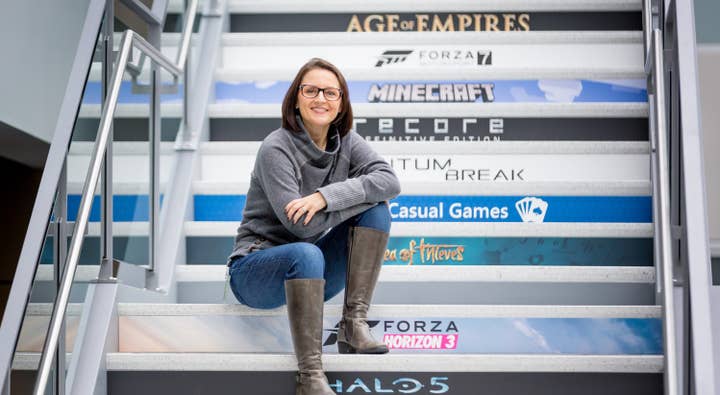Xbox launches new resource to help developers add inclusion into their games | GDC 2024
"If you don't intentionally include, you will unintentionally exclude"
Xbox has launched the 'Gaming For Everyone Product Inclusion Framework', a series of resources and information on how to make games more inclusive.
It was announced during a talk at GDC 2024 in San Francisco, and covers four key areas of 'globalisation, accessibility, representation and approachability'. The Framework was first launched internally in 2019, and now Microsoft is making it available for other studios here.
The project is led by the firm's Gaming for Everyone team, which started in 2015 in order to bring 'gaming to everybody on the planet'.
"What we found in the early days of Gaming For Everyone, is that people – even internally – got inspired by the idea," Katy Jo Wright, Xbox's head of Gaming for Everyone & Sustainability, tells GamesIndustry.biz.
"And we saw teams who went on and did things that brought it to life, like the Xbox Adaptive Controller. But we wanted to see it consistently across the organisation. So my team went on this listening tour inside Xbox to understand what was going on and how people were making it real. That is how we discovered people were inspired by Gaming For Everyone, but they didn't know how to translate that into their own day-to-day. It was: 'if I'm not a decision maker determining what hardware we build, how do I make it real?'
"We were like 'ah'. Because our messaging was around how it is up to each of us to make decisions, every day, to bring this intentionality to include. It was doing that learning that set us onto another journey to create what is now the Product Inclusion Framework."

The framework goes public at a time where a small subset of gamers have been pushing against diversity efforts in games. Are there concerns that perhaps some developers might become wary of introducing some of the ideas put forward in the framework? Wright doesn't think so.
"We started doing this because, as developers, we want to get our games played by as many people as possible. It's all about expanding reach," she explains.
"When you talk to a developer… do you want to limit how many people play your game? No. That's how we think about it. Then each developer gets to make the decision for themselves over who they want to expand their player reach to.
"The framework is not a checklist. It's not a mandate. Even internally, it's not that at all. It's just… a way for you to get your game into the hands of more players in a meaningful way."
Wright uses the notion of 'doorways', and how for some people the doorway to gaming is closed. The framework shares guidance and ideas on how to open those doorways, but that doesn't mean every game should be looking to open every doorway.
"It's not about opening every door for every type of game, because that could make the game vanilla. It's not about making every game for everyone, it's about making gaming for everybody. It's about how can we bring that level of intentionality, so you as a developer can make the right decision for your experience. We will connect you to a bunch of different resources, so that people are aware and can make an informed decision about their game."
She adds: "It is about intentional decisions. Do we want to open this door or leave it closed? Or do we want to lock this door? Sometimes it is the right thing to lock the door. For example, with age gating. Not every four-year-old should be able to play every game. But there are many doors along the gaming journey, and they are there whether we are making an intentional decision or not, and many times they are closed be default.
"In every game it is a matter of do we want to open the door? [This Framework] can apply to every single game, but it is up to each developer to decide whether it is the right thing for the experience they're making."
"It's not about making every game for everyone, it's about making gaming for everybody"
The Framework isn't just about development, either.
"It can apply to every game, or even every experience, even on the Xbox store, in every press article we put out, in our marketing… it can apply everywhere," Wright tells us.
"When we created it, we worked really hard to create resources and tools at an altitude that anyone at team Xbox can use, including PR or marketing or anyone. It's not just about studios."
Going back to the anger some gamers are showing towards inclusivity initiatives, Wright believes the right approach is to focus on the good that gaming can bring and not put a spotlight on some of those negative areas.
"I believe there are more people that think gaming is an incredible medium that can really connect people. We saw during the pandemic that people craved a human connection, and gaming was a way to achieve that.
"The more that we can talk about the good that gaming can bring, and the impact… and give that the energy and the spotlight. Yes, there's a threshold when there's harassment. We need to be very aware of that in terms of safety and making our beliefs clear."
Wright shares a stat from a survey where 71% of players say that diversity in stories and characters is either 'very' or 'extremely important' to them.
"The clear majority of players value that. And we just know that to be true as humans."
Xbox's four main doorways are what we mentioned above: globalisation, accessibility, representation and approachability. And the firm has a series of examples of how it's approached each one.

For approachability, which is around people being made to feel safe and welcome, the big one is Game Pass, which makes gaming more affordable. But there is also Xbox Ambassadors, who have to sign a pledge around making an inclusive gaming community, and are often given quests to find new players and welcome them in.
For representation, that would include the ID@Xbox game Venba, which is about an immigrant Indian family living in Canada. "Even if people don't play it," says Wright. "Knowing it's there makes them feel like they belong."
Other examples of representation include the body type options in Sea of Thieves, or the mental health portrayal in Hellblade.
"We talk a lot about the intent to impact," Wright adds. "We can have the best of intentions, but the important part is making sure the impact lands. Making sure it lands in a relatable way and is respectable… that's tricky and requires a lot of work in being intentional in the decision making that you make along the game dev process."
In terms of globalisation, Xbox has language tags on its store, so gamers can search by their preferred language and see all games localised for them. Meanwhile, there's Forza Horizon 5, which is based in Mexico and used consultants to make sure "the local community and culture was represented authentically"
"If you want to include, you have to be intentional about that"
Then finally there's the accessibility door. The Xbox Adaptative Controller is the best example of this, but there's also something that Microsoft does for developers called XAIL.
"It stands for Xbox Accessibility Insider League," Wright tells us. "This is a resource for any developer, where they can get feedback from people with disabilities on the accessibility features of their game. That is an example of us opening up that accessibility doorway, which is not something that gets a lot of press."
The Product Inclusion Framework is about sharing all this with developers, Wright says. And hopefully that will result in new learnings.
"We're creating a Discord channel so that we can engage in a dialogue. Because we want to learn what other people are learning," Wright says. "We are committed to updating this resource hub."
She adds: "There is so much creativity in this industry, I can only imagine where this can go. Seeing other people take this framework and applying it in a new way, and maybe identifying new doors that we had never even seen before… Where we go next is an even broader definition of shared learning."
Ultimately, it's all around the intention to be inclusive, concludes Wright. If you have that intention, the framework can then be a guide in how to make it real.
"If you don't intentionally include, you will unintentionally exclude. That is how we are as human beings. There is no shame in that. If you want to include, you have to be intentional about that."









